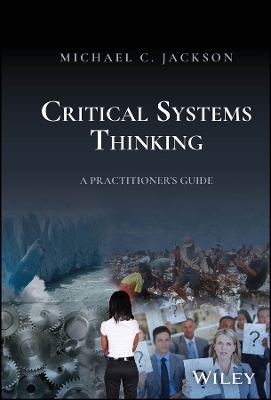
Critical Systems Thinking
John Wiley & Sons Inc (Verlag)
978-1-394-20357-4 (ISBN)
Leaders and managers face increasing complexity and uncertainty because technical, organizational, socio-cultural, political, and environmental issues have become intensely interconnected. Systems thinking is recognized as the essential competence for managing complexity. As the demand for systems thinking grows, however, the fragmentation of the field into different methodologies has become a potential liability. Critical systems thinking (CST) shows how this diversity can be a strength rather than a weakness by revealing how different systems methodologies address various aspects of complexity and how they can be used in combination to resolve the messiest of wicked problems.
Critical Systems Thinking offers, in a single volume, an account of the value of systems thinking and CST in the modern world, an explanation of the pragmatic philosophy and expansion in mindset necessary to embrace CST, and detailed instructions on how to undertake critical systems practice (CSP) using the variety of systems approaches to navigate multi-dimensional complexity.
Readers will find:
An accessible introduction to systems thinking and CST.
A description and critique of the best-known systems methodologies.
A guide to the mindset changes, the steps required, and the toolkit necessary to undertake successful CSP.
Case studies and examples of CSP.
A discussion of the nature of systemic leadership.
Critical Systems Thinking is ideal for leaders and managers in government, business, the public sector, the professions, and beyond who want to understand the potential of systems thinking and use it in their work. It is essential for systems researchers and practitioners who want a deeper understanding of the field.
Dr Michael C. Jackson is an established expert in systems thinking and the major figure in the development of CST. He is Emeritus Professor, and former Dean of the Business School, University of Hull, UK, and Managing Director of Systems Research Ltd. He has served as President of the International Federation for Systems Research and the International Society for the Systems Sciences. He was awarded an OBE by Her Majesty the Queen (2011) for services to business and higher education, the Beale Medal of the UK Operational Research Society (2017), and the Pioneer Award of the International Council on Systems Engineering (2022). His previous book for Wiley, Critical Systems Thinking and the Management of Complexity (2019), is regarded as the definitive account of the history of systems thinking and the different systems methodologies.
Preface xi
Acronyms xv
Introduction xvii
Part 1 The Emergence of Critical Systems Thinking 1
1 The Scientific Method 3
1.1 Introduction 3
1.2 Early Systems Thinking 4
1.3 The Ascendancy of the Scientific Method 5
1.4 Romanticism and Disquiet 7
1.5 The Challenge of Complexity 10
1.6 Science and the Scientific Method in the Spotlight 13
1.7 Conclusion 15
References 17
2 Systems Thinking 19
2.1 Introduction 19
2.2 The Challenge Confronting Systems Thinking 20
2.3 Complexity and Wicked Problems 21
2.4 The Search for General Systems Laws 24
2.4.1 Bogdanov and Tektology 24
2.4.2 Von Bertalanffy and General Systems Theory 25
2.4.3 Wiener and Cybernetics 27
2.4.4 Complexity Theory 30
2.5 The ‘Problem’ of Emergence 34
2.6 A Pluralistic Approach to the Use of Systems Thinking 38
2.7 The Development of Systems Methodologies 39
2.8 Conclusion 41
References 42
3 Critical Systems Thinking 47
3.1 Introduction 47
3.2 The Origins and Early Development of Critical Systems Thinking 48
3.3 Systemic Critique 50
3.4 Systemic Pluralism 52
3.5 Systemic Improvement 53
3.6 The Argument for Systemic Pragmatism 55
3.6.1 From Paradigms to Pragmatism 55
3.6.2 What Is Pragmatism? 56
3.6.3 Towards Systemic Pragmatism 59
3.7 Conclusion 64
References 64
Part 2 Critical Systems Practice 69
4 Critical Systems Practice: An Overview 71
4.1 Introduction 71
4.2 The Origins of Critical Systems Practice 71
4.3 Contemporary Critical Systems Practice 72
4.3.1 Essence 72
4.3.2 The EPIC Framework 73
4.3.3 The Four Stages 73
4.3.3.1 Explore the Situation of Interest 73
4.3.3.2 Produce an Intervention Strategy 75
4.3.3.3 Intervene Flexibly 76
4.3.3.4 Check on Progress 76
4.4 Considerations on the Nature of Critical Systems Practice 77
4.5 Related Approaches 79
4.6 Conclusion 82
References 82
5 Critical Systems Practice 1 – Explore the Situation of Interest 85
5.1 Introduction 85
5.2 Explore – Preliminaries 85
5.2.1 Metaphors and World Hypotheses in Philosophy 87
5.2.2 Paradigms and Metaphors in Organisation Theory 89
5.2.3 Multiperspectival Approaches in Systems Thinking 91
5.3 Explore – Process 91
5.3.1 View the Situation of Interest from Five Systemic Perspectives 92
5.3.1.1 The Mechanical Systemic Perspective 93
5.3.1.2 The Interrelationships Systemic Perspective 94
5.3.1.3 The Organismic Systemic Perspective 95
5.3.1.4 The Purposeful Systemic Perspective 97
5.3.1.5 The Societal/Environmental Systemic Perspective 99
5.3.2 Identify Primary and Secondary Issues 100
5.4 Explore – Example: The Early Days of the COVID- 19 Pandemic in the United Kingdom 101
5.5 Explore – Issues 106
5.6 Conclusion 109
References 110
6 Critical Systems Practice 2 – Produce an Intervention Strategy 113
6.1 Introduction 113
6.2 Produce – Preliminaries 114
6.3 Produce – Process 115
6.3.1 Appreciate the Variety of Systems Approaches 115
6.3.2 Choose Appropriate Systems Methodologies 118
6.3.2.1 Engineering Systems Methodologies 118
6.3.2.2 System Dynamics 122
6.3.2.3 Living Systems Methodologies 127
6.3.2.4 Soft Systems Methodologies 134
6.3.2.5 Emancipatory Systems Methodologies 141
6.3.3 Choose Appropriate Systems Models and Methods 145
6.3.4 Structure, Schedule and Set Objectives for the Intervention 145
6.4 Produce – Examples 146
6.5 Produce – Issues 149
6.6 Conclusion 152
References 153
7 Critical Systems Practice 3 – Intervene Flexibly 159
7.1 Introduction 159
7.2 Intervene – Preliminaries 159
7.3 Intervene – Process 160
7.3.1 Use Systems Methodologies, Models and Methods Flexibly 160
7.3.2 Stay Alert to the Evolving Situation (Revisit Stage 1) 160
7.3.3 Stay Flexible About Appropriate Methodologies, Models and Methods (Revisit Stage 2) 160
7.4 Intervene – Examples 162
7.5 Intervene – Issues 169
7.6 Conclusion 170
References 170
8 Critical Systems Practice 4 – Check on Progress 173
8.1 Introduction 173
8.2 Check – Preliminaries 174
8.2.1 Systemic Evaluation: The Single Systems Methodology Approach 176
8.2.2 Systemic Evaluation: The Systems Concepts Approach 177
8.2.3 Systemic Evaluation: The Critical Systems Thinking Approach 180
8.3 Check – Process 181
8.3.1 Evaluate the Improvements Achieved 181
8.3.2 Reflect on the Learning Gained About the Systems Approaches Used 182
8.3.3 Discuss and Agree Next Steps 184
8.4 Check – Examples 184
8.5 Check – Issues 187
8.6 Conclusion 189
References 189
Part 3 Towards a Systems Thinking World 193
9 Critical Systems Leadership: Overcoming the Implementation Barriers 195
9.1 Introduction 195
9.2 The Growing Interest in Systems Thinking 196
9.3 Overcoming the Barriers to Implementation 200
9.3.1 Misconceptions About Systems Thinking 201
9.3.2 Problems with Systems Thinking 201
9.3.3 Contextual Factors 205
9.4 Critical Systems Leadership 209
9.4.1 Attributes of Critical Systems Leadership 210
9.4.1.1 Collective Leadership and Collaboration 210
9.4.1.2 Communication of a Vision and Open Dialogue 210
9.4.1.3 Co- creation 211
9.4.1.4 Attention to Managing the Collaboration 211
9.4.1.5 An Open Approach to Learning 211
9.4.1.6 An Ethical Orientation 211
9.4.1.7 Promotion of Appropriate Evaluation 211
9.4.2 Mindset for Critical Systems Leadership 212
9.4.3 Methodological Competence for Critical Systems Leadership 212
9.5 Conclusion 213
References 214
Conclusion 219
Index 223
| Erscheinungsdatum | 10.05.2024 |
|---|---|
| Verlagsort | New York |
| Sprache | englisch |
| Maße | 158 x 231 mm |
| Gewicht | 476 g |
| Themenwelt | Mathematik / Informatik ► Mathematik ► Finanz- / Wirtschaftsmathematik |
| Technik ► Elektrotechnik / Energietechnik | |
| Wirtschaft ► Betriebswirtschaft / Management ► Unternehmensführung / Management | |
| ISBN-10 | 1-394-20357-8 / 1394203578 |
| ISBN-13 | 978-1-394-20357-4 / 9781394203574 |
| Zustand | Neuware |
| Informationen gemäß Produktsicherheitsverordnung (GPSR) | |
| Haben Sie eine Frage zum Produkt? |
aus dem Bereich


